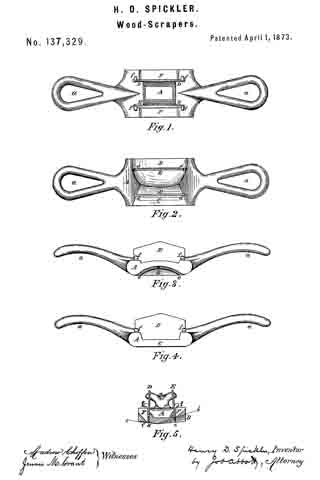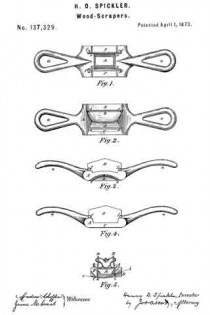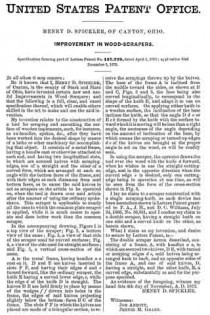No. 137,329 – Improvement In Wood-Scrapers (Henry D. Spickler) (1873)

UNITED STATES PATENT OFFICE.
_________________
HENRY D. SPICKLER, OF CANTON, OHIO.
IMPROVEMENT IN WOOD-SCRAPERS.
_________________
Specification forming part of Letters Patent No. 137,329, dated April 1, 1873; application filed December 5, 1892.
_________________
To all whom it may concern:
Be it known that I, HENRY D. SPICKLER, of Canton, in the county of Stark and State of Ohio, have invented certain new and useful Improvements in Wood- Scrapers; and that the following is a full, clear, and exact specification thereof, which will enable others skilled in the art to make and use the said invention.
My invention relates to the construction of a tool for scraping and smoothing the surface of wooden implements, such, for instance, as ax-handles, spokes, &c., after they have been worked into the desired shape by means of a lathe or other machinery for accomplishing that object. It consists of a metal frame, having a handle cast or otherwise attached at each end, and having two longitudinal slots, in which are secured knives with scraping-edges, one of a straight and the other of a curved form, which are arranged at such an angle with the bottom faces of the frame, and with their edges at such distances from said bottom faces, as to cause the said knives to act as scrapers on the article to be operated on, when the tool is drawn over said article after the manner of using the ordinary spoke-shave. This scraper is applicable to nearly all the uses to which the common plate scraper is applied, while it is much easier to operate and does better work than the common scraper.
In the accompanying drawing, Figure 1 is a top view of the scraper; Fig. 2, a bottom view of the same 5 Fig. 3, a view of that side of the scraper used for curved surfaces; Fig. 4, a view of the side used for straight surfaces; and Fig. 5, a vertical cross-section of the same.
A is the metal frame, having handles a a cast on it. D and E are knives inserted in slots F F, and having their edges d and e turned forward, like the ordinary scraper, the knife E having a curved lower edge, e, while the edge d of the knife D is straight. The knives D E are held firmly in place by means of the wedges f f driven into holes in the frame, the edges of said knives projecting slightly below the bottom-faces B C of the frame. The slots F F in which the knives are placed are made of a triangular section, to receive the scrapings thrown up by the knives. The base of the frame A is inclined from the middle toward the sides, as shown at B and C, Figs. 2 and 5, the face being also curved longitudinally, to correspond to the shape of the knife E, and adapt it to use on curved surfaces. On applying either knife to a wooden surface, the inclination of the base inclines the knife, so that the angle D d c or E e b formed by the knife with the surface toward whichit is moving will be less than a right angle, the acuteness of the angle depending on the amount of inclination of the base, by which means the scraping or turned-up edges d e of the knives are brought at the proper angle to act on the wood, as will be readily seen.
In using the scraper, the operator draws the tool over the wood with the knife d forward, when he wishes to use the straight cutting-edge, and in the opposite direction when the curved edge e is desired, only one cutting edge being in operation at one time, as will be seen from the form of the cross-section shown in Fig. 5.
I lay no claim to a scraper constructed with a single scraping-knife, as such device has been heretofore shown in Letters Patent granted to F. A., J. H., and D. C. Williams, July 24, 1866, No. 56,651, and I confine my claim to a double scraper, having a straight knife on one side and a curved knife on the other, as herein shown.
What I claim as my invention, and desire to secure by Letters Patent, is —
The double scraper herein described, consisting of a frame, A, with handles a a, in which are secured two knives, D E, with turned or scraping edges d e, said knives being arranged back to back, and on opposite sides of the frame A, and one of said knives, D, having a straight, and the other knife, E, a curved edge, substantially as and for the purpose specified.
As evidence of the foregoing, witness my hand this 4th day of November, A. D. 1872.
HENRY D. SPICKLER.
Witnesses:
JOB ABBOTT,
JENNIE M. GRANT.


